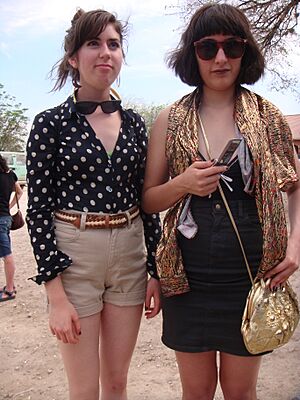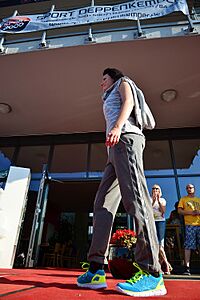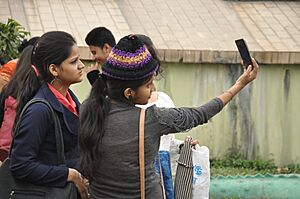Street style facts for kids
Street style is a type of fashion that comes from everyday people, not from big design studios. It's often linked to youth culture and is most common in large cities. You'll often see photos in magazines and newspapers of people wearing cool, stylish clothes they put together themselves. Mainstream fashion often takes ideas from street style trends. Many youth subcultures have their own unique street fashion. Street style looks different all over the world!
Contents
What is Street Style?
Street style is often about showing off your own unique look, rather than just following the latest trends. People use street style to express who they are, mixing different styles and trends. It's like a performance where you can explore your identity through the clothes you wear.
Bill Cunningham, a famous photographer for The New York Times, said that street style is a great way to see what ordinary people are wearing. He believed that the streets tell a lot about fashion and people, if you pay attention. For him, the best fashion show happens every day on the streets.
Street style is a fast-moving part of fashion. It has changed how clothes are made and how people buy them. Because styles change so quickly, it also makes us think about "fast fashion" – buying and wearing clothes that are made cheaply and quickly.
How Did Street Style Grow?
Street style has always been around, but it became a big deal in the 20th century. After World War II, life became more similar for many people, with things like suburbanization and mass marketing. This might have made people want "alternative" lifestyles to find their own "identity."
Fashion used to flow from high-end designers down to everyday clothes. But street style showed that new trends could also start with groups who didn't have much money or were on the edges of society. These "metropolitan tribes" could spark new fashion ideas that spread everywhere.
Experts have studied how important young people's street styles were after the war, especially with the rise of the "baby boomers." This generation became known as "teenagers" who had money to spend. They became a big influence on both the economy and culture.
The way we dress is closely linked to who we are. Street style helps groups of people feel connected and show their shared identity. After World War II, traditional ways of defining identity, like race or religion, became less important in Western culture. Instead, groups like:
- Bikers, beats, and teddy boys in the 1950s
- Mods, hippies, and skinheads in the 1960s
- Headbangers, punks, and b-boys in the 1970s
- Goths, new age travelers, and ravers in the 1980s
These groups used unique clothes and body decorations to create a sense of identity. This helped them show who they were and what group they belonged to.
In the early 1900s, fashion photos of women on the street often showed them in fancy, high-end clothes. The street was just a pretty background for expensive fashion. But after the war, with the rise of magazines for men, the idea of the "man about town" started to appear in fashion photos. This showed how men's style was influenced by city life. Later, young people became a social group, and they made street culture their main way of expressing themselves through fashion.
Sportswear's Impact
Street style often includes everyday people wearing sportswear. But it's also influenced by supermodels who work for big sportswear brands. This makes it easier for sporty clothing to become popular with everyone.
Skateboarding has especially shaped certain street styles. The look of many street style followers often matches skateboarding culture. For example, skate shoes, which help feet grip the board, are now worn by many people who don't even skateboard.
Where Street Style Thrives
Designers, street style fans, trendsetters, bloggers, fashion stores, and models all influence a city's fashion scene. These trends can highlight popular shopping and entertainment areas. Cities often use their unique fashion to attract visitors and shoppers.
Milan
Milan is home to many important fashion schools, agencies, and events, like Milan Fashion Week. People often call Milan the 'capitale della moda' (fashion capital) because of its styles, city life, fashion collections, and designers. This makes other cities want to be seen as fashion capitals too.
Paris
Paris is known for its fashion trends, designers, and a chic, luxurious feel. It's also famous for artists and a bohemian lifestyle. Paris creates a unique "city look" where certain clothes and lifestyles represent the city's vibe. For example, "La Parisienne" – the typical Parisian woman – has a certain style, manners, and values linked to the city. Paris is often seen as a romantic city of love and fashion, full of dreams.
Japan
Japanese fashion has inspired many fashion experts in the West. Designers like Kenzō Takada, Issey Miyake, and Yohji Yamamoto became famous in Paris starting in the 1970s. Japan is now a major force in the fashion world. Today's Japanese fashion influences both how clothes look and how the fashion business works.
Japanese street fashion has many different styles happening at the same time. It doesn't come from famous Japanese designers. Instead, it's often led by high school girls who have become very influential in setting trends. These fashion-loving young people directly and indirectly decide what's popular. They are like the "agents of fashion," helping to create and spread new styles. Japanese street fashion comes from connections between different fashion groups and various street subcultures. Each subculture has its own unique look. These teens use their distinct appearance to show their group identity. This identity isn't about politics; it's simply about new fashion that defines their group.
London
London is also a major fashion capital. But unlike Milan and Paris, London's style is closer to royalty, traditions, and a strong street style culture. The city was a leader in developing second-hand markets and underground fashion trends. London is a diverse city with many cultures. This means its street style often shows not just popular fashion ideas, but also social and cultural identity.
London is a street style center in Europe because British fashion people are often more open to new ideas and working with young, promising designers. This open-mindedness helps promote street style and sustainable fashion practices.
New York
The idea of photographing models in front of warehouses or on the street, still in their runway makeup, started in New York. American culture has greatly influenced street style. Think of the Gibson Girl of the 1890s, the free-spirited Flappers of the 1920s, and the tough work clothes of the 1930s and 40s. Music movements like jazz, rock, disco, and hip hop have also played a big role. American sports like basketball, baseball, surfing, and skateboarding have influenced fashion too. Counterculture movements like the hippy movement, punk, and grunge also created unique "anti-fashion" looks. And Hollywood movies have had a huge impact on New York's fashion and design.
New York Fashion Week was the first fashion week in the world. Famous fashion magazines like Vogue, Harper's Bazaar, and Cosmopolitan have been top fashion publications for over a century. Neighborhoods like the East Village, Greenwich Village, and Williamsburg, Brooklyn have been popular spots for street style. Williamsburg, for example, helped bring back the hipster style in the 2000s and 2010s.
India
Street style in India is growing, often by copying looks from Hindi cinema (Bollywood movies). Indians love fashion, and different religions and cultures in India help create unique street styles.
Examples of Street Styles
Here are some examples of street styles from different decades:
- Hippies (1960s): denim, bohemian style, long hair, flower power, flared trousers.
- Teddy Boys (1950s): long drape jackets, tight "drainpipe" trousers, crepe shoes.
- Punk fashion (1970s): ripped clothing, safety pins, spiky Mohican hairstyles.
- Skinheads (1960s): short-cropped hair, fitted jeans, Ben Sherman shirts, Fred Perry polo shirts, Harrington jackets, Dr. Martens boots.
- Gothic fashion (1980s): black clothing, heavy coats, poet shirts, big boots, dark makeup.
- Preppy (1980s): argyle sweaters, chinos, madras fabric, Nantucket Reds pants, button down Oxford cloth shirts, and boat shoes.
- See also ghetto prep for a modern version influenced by hip-hop fashion.
- Hip hop fashion (1990s-2000s): very baggy pants, brands like ECKO, Tribal Gear, South Pole, Avirex, FUBU, Sean Jean, NIKE.
- Hipster or indie (2000s-2010s): glasses, jeans, beanies, sneakers, ties, suspenders, checked shirts, beards.
- Trendies (2000s): androgynous big hair, bright neon colors, skinny jeans, printed hoodies, keffiyeh scarves.
- Rasta (1970s onwards): African-inspired clothing, rastacap hats, dreadlocks.
- Greaser (1950s): Levis 501 jeans, T-shirts, leather jackets, sunglasses, Cowboy boots or motorcycle boots, lots of hair gel.
- Urban (2000s onwards): colorful clothes, large accent jewelry, skinny jeans, jackets, T-shirts.
- Feminine (general): dresses, hats, sunglasses, hand bags, floral prints.
- Kawaii (Japan): tutu skirts, pastel and pink colors, anime-inspired items, childish and Gothic Lolita accessories like wild hair clips or bows.
See also
- Consumer Behaviour
- Counterculture
- Cultural appropriation
- Fashion Design
- Haute Couture
- Streetwear
- Subculture







